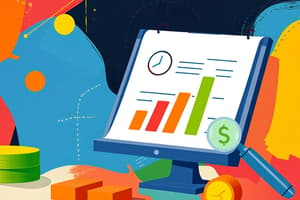Podcast
Questions and Answers
What is the primary objective of costing?
What is the primary objective of costing?
- To determine the profitability of different products
- To maximize profits
- To set competitive prices
- To control expenses (correct)
What is the main purpose of job costing?
What is the main purpose of job costing?
- To set prices for services
- To determine the cost of a particular product (correct)
- To analyze the profitability of different departments
- To control waste and scrap
Which of the following is NOT a type of costing technique?
Which of the following is NOT a type of costing technique?
- Activity-based costing
- Process costing
- Job costing
- Financial costing (correct)
What is the purpose of conducting profitability analysis?
What is the purpose of conducting profitability analysis?
What is the definition of costing?
What is the definition of costing?
What is the purpose of standard costing?
What is the purpose of standard costing?
What is the main difference between job costing and process costing?
What is the main difference between job costing and process costing?
What is the purpose of activity-based costing?
What is the purpose of activity-based costing?
What is the main purpose of costing in an organization?
What is the main purpose of costing in an organization?
What is the relationship between costing and profitability?
What is the relationship between costing and profitability?
What type of loss is considered avoidable and usually due to inefficiencies or accidents?
What type of loss is considered avoidable and usually due to inefficiencies or accidents?
How is the cost of normal loss treated in accounting?
How is the cost of normal loss treated in accounting?
What is the main difference between waste and scrap?
What is the main difference between waste and scrap?
What is the purpose of understanding costing and costing techniques?
What is the purpose of understanding costing and costing techniques?
What type of loss is considered normal and is absorbed by the good units produced?
What type of loss is considered normal and is absorbed by the good units produced?
What is the term for materials or by-products that are discarded during the production process but have some residual value?
What is the term for materials or by-products that are discarded during the production process but have some residual value?
Why is it important to manage scrap properly?
Why is it important to manage scrap properly?
What is the term for materials or products that are discarded during the production process and have no value?
What is the term for materials or products that are discarded during the production process and have no value?
What is the benefit of accurately determining costs?
What is the benefit of accurately determining costs?
What is the purpose of treating abnormal loss separately?
What is the purpose of treating abnormal loss separately?
What is the primary purpose of cost analysis in organizations?
What is the primary purpose of cost analysis in organizations?
Which of the following is a use of costing information in management decisions?
Which of the following is a use of costing information in management decisions?
What is the term for the costs of raw materials and components used in the production process?
What is the term for the costs of raw materials and components used in the production process?
What is the difference between direct and indirect labor costs?
What is the difference between direct and indirect labor costs?
What is the term for costs other than direct materials and direct labor?
What is the term for costs other than direct materials and direct labor?
What is the sum of direct materials and direct labor costs?
What is the sum of direct materials and direct labor costs?
What is the type of costing technique used in industries where production is carried out based on specific customer orders?
What is the type of costing technique used in industries where production is carried out based on specific customer orders?
What is the characteristic of Process Costing where costs are accumulated for each process or stage of production?
What is the characteristic of Process Costing where costs are accumulated for each process or stage of production?
What is the term for the expected or unavoidable loss that occurs during the production process?
What is the term for the expected or unavoidable loss that occurs during the production process?
What is the purpose of inventory valuation in costing?
What is the purpose of inventory valuation in costing?
Study Notes
Introduction to Costing and Costing Techniques
- Costing is the process of determining the cost of a particular product or service.
- Costing techniques are methods used to ascertain the cost of products or services.
- Common costing techniques include job costing, process costing, activity-based costing, and standard costing.
Objectives of Costing
- Cost control: to control expenses by identifying and analyzing cost components.
- Pricing decisions: to set competitive prices that cover costs and provide a reasonable profit margin.
- Profitability analysis: to analyze the profitability of different products, services, or departments.
- Budgeting and forecasting: to provide a basis for budget estimates and financial forecasts.
- Inventory valuation: to accurately value inventory for financial reporting.
- Decision making: to support various management decisions.
Elements of Costs
- Material costs: costs of raw materials and components used in production.
- Labor costs: wages and salaries paid to employees involved in production.
- Overhead costs: all costs other than direct materials and direct labor.
Components of Cost
- Prime cost: sum of direct materials and direct labor costs.
- Factory cost: prime cost plus manufacturing overheads.
- Cost of production: factory cost plus administrative overheads.
- Total cost: cost of production plus selling and distribution overheads.
Job Costing
- Used to ascertain the cost of specific jobs or orders.
- Suitable for industries where production is based on specific customer orders.
- Features of job costing:
- Each job is treated as a separate entity.
- Direct costs are easily traceable to specific jobs.
- Overheads are allocated to jobs based on predetermined rates or actual usage.
- Provides detailed cost information for each job.
Process Costing
- Used in industries where production is continuous and products pass through multiple processes.
- Suitable for industries such as chemicals, textiles, and food processing.
- Features of process costing:
- Costs are accumulated for each process or stage of production.
- Average costs are calculated by dividing the total costs of each process by the number of units produced.
- Ideal for homogeneous products.
- Provides information on the cost of each process.
Normal and Abnormal Losses in Process Costing
- Normal loss: expected or unavoidable loss that occurs during the production process.
- Abnormal loss: loss that exceeds the expected normal loss.
- Normal loss is absorbed by the good units produced, while abnormal loss is treated separately and recorded as a separate expense.
Waste and Scrap
- Waste: materials or products that are discarded during the production process and have no value.
- Scrap: materials or by-products that are discarded during the production process but have some residual value.
- Proper management of scrap can help in recovering some of the costs and reducing overall production expenses.
Studying That Suits You
Use AI to generate personalized quizzes and flashcards to suit your learning preferences.
Description
This quiz covers the basics of costing and costing techniques, including definitions, objectives, elements of costs, job costing, process costing, and normal and subnormal losses. Test your understanding of these fundamental concepts in accounting and financial management.




